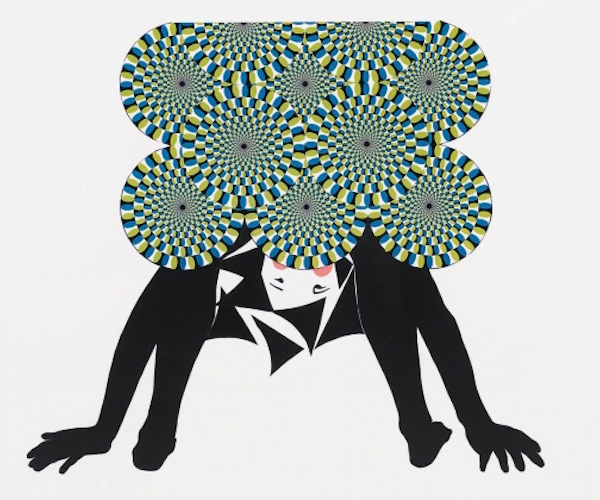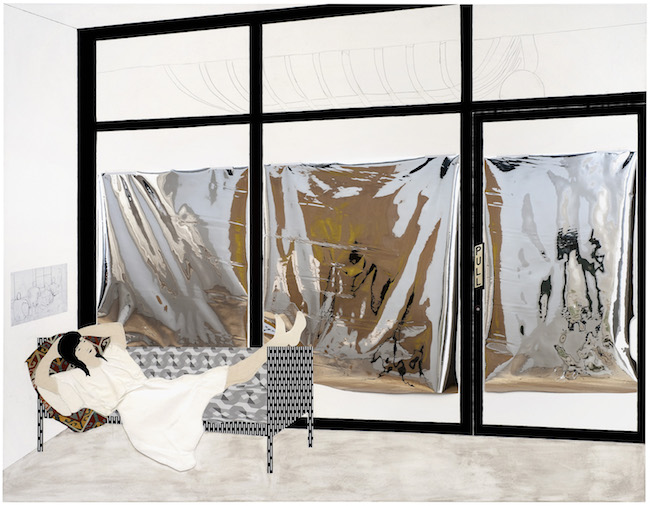Visual Arts Review: Frances Stark — The Art of Innuendo
Is the autobiography so preponderant as to obliterate reflection upon what the work might mean for the rest of us? Maybe that’s the proper mode of art-making for the Age of the Selfie.

Frances Stark, Chorus girl folding self in half, 2008. Paper collage, graphite on paper. Photo: Whitney Museum of American Art.
By Franklin Einspruch
The catalog for UH-OH: Frances Stark 1991-2015 (at the Museum of Fine Arts, Boston through January 29, 2017) begins with an essay by curator Ali Subotnick. She cites in Stark’s work an “abundance of themes” including, “in no particular order: writing, procrastinating, the banality of life, failure, success, pride, self-doubt, motherhood, pedagogy, institutional critique, music, literature, poetry, philosophy, art, money, flowers, sadness, frustration, Stark herself, Arlo (her son), and ‘Bobby Jesus’ (more on him later).”
Consequently, this review will also encompass an abundance of themes, including, in no particular order: what it’s like to write about exhibitions like this, and the despair a critic feels when he reads that one of the themes running through someone’s art is art. More on that later. (You’re on your own for Bobby Jesus.)
Stark told a crowded press preview this past Friday that she did not have a background in art and was not one of those kids who had always wanted to make it. This is the case of many artists who have garnered traction in the contemporary museum world, going into an MFA in Visual Art, or into the art world directly, after procuring some other sort of Bachelor’s degree. In fact, an art background may be turning into a liability. You risk becoming interested in techniques and objects in a world whose gatekeepers are mainly interested in, as mentioned above, themes.
Stark earned a BA in Humanities at San Francisco State University and hung around the Bay Area punk scene in the late ’80s. She became interested in the sort of anything-goes art exemplified by Mike Kelley, who was also deeply connected to punk, and with whom she eventually studied at Art Center College of Design in Pasadena. Her application to ArtCenter included a photo of her posing in a bikini and heels (which, for the record, she rocked; the catalog includes it) next to a Suzuki in the desert. Writing had always played a role in her life, so text figures prominently in her work and her poetry and essays have appeared in many publications. The DIY aesthetic of punk prompted her to design her own show announcements.

Pull After “Push,” 2010. Frances Stark. Image courtesy of greengrassi, London. Photo: Robert Wedemeyer, courtesy Museum of Fine Arts, Boston.
This is someone who is interested in music, but not enough to start a band and cut an album. She writes, in short forms. She understands graphic design well enough to use it ironically but isn’t the type (sorry) to fret over bad kerning. She’s comely, but not enough for the runway. (I would not bring this up if she hadn’t consciously leveraged her attractiveness for the sake of her work.) Her mightiest endowment, by far, is her capacity for oversharing, which is the source of the “uh-oh” in the exhibition title. Twenty fewer points of IQ and she probably would have gone into porn.
Instead she worked out a multi-disciplinary practice of visual autobiography, taking the form of drawings, paintings, collages, and videos, and here she is filling the MFA’s Linde Family Wing with them. Like everything else she does, she’s good but not superlative at it. Danica Phelps draws more movingly and her conceptualism is more urgent. Jim Hodges is capable of greater pathos and bigger scales. But Stark’s best work is reminiscent of Laura Owens’s, back when she was still painting well, ten years ago, and evoking a sweetly flavored self-consciousness about art-making when she quoted other sources unabashedly.
2010 was an especially fruitful year for Stark, when she produced a series of depictions of her studio. These eight-foot wide paintings with collage elements are formally convincing and encode a lot of information about what goes on in her creative process. Push After “Pull After Push” shows an open storefront door, labeled “PUSH,” with the kind of stick-on letters that one would use for that purpose. Likewise, the view through the plate glass is blocked by an actual sheet of mylar. Clippings appear on the wall behind it, as is common in artists’ studios, but in this composition they seem to be floating in through the open door, towards another painting begun in pencil. Those clippings include the Sylvia Sleigh feminist switcharoo of Ingres’ Turkish Bath from 1974, as well as a photo of Soulja Boy. (Sylvia Sleigh has never had a retrospective in an American museum, which is a shame and ought to be remedied.) Stark is working out a problem of objectified sexuality that includes hers: note the title.

“If conceited girls want to show they already have a seat (after Goya),” 2008. Frances Stark. Image courtesy of greengrassi, London. Photo: Ellen Wilson, courtesy Museum of Fine Arts, Boston.
Innuendo is never far from Stark’s art. When the catalog describes Stark, describing herself, as promiscuous (she brought this up in so many words at the press preview), she means her eagerness to accept offers to teach, speak, write, and otherwise hustle on behalf of her career, but that isn’t all she means. She divulged to the New York Times Magazine last year that her approach to the men her life is whatever would be the female equivalent of “womanizing.” The video works reproduce her conversations with virtual paramours from Chatroulette. They’re played out with toy figures (My Best Thing, 2012) or plain text (Osservate, leggete con me, 2012) but the verbal details are unstintingly explicit. They also meander, as conversations do, into distant territory: politics, the economic crisis, old memories. The surprise is how boring it all is. From where the viewer observes, it might as well be ethnographic data stored in Excel.
More interesting is the series of collages she made after one of Goya’s Caprichos. If conceited girls want to show they already have a seat (after Goya) (2008) shows a female figure in black stockings under a scrim through which one nipple and her pubis shows, and, following that particular Goya print, a chair on her head. Goya was making a pun on asiento (seated) and siento (sense or feel), and Stark is extending it to symbolize the trouble that women sometimes have to go through to be thought of as conscious beings. Materially, the series is on the chintzy side, which is a distraction.
That brings up the problem of criticizing this work. Does the craftsmanship of Conceited girls seem insufficient? Perhaps it’s meant to lend an air of informality. Do the videos seem banal? Maybe banality is the point. Is the autobiography so preponderant as to obliterate reflection upon what the work might mean for the rest of us? Maybe that’s the proper mode of art-making for the Age of the Selfie. Do the drawings of tiny letters and tiny birds seem twee? Perhaps that’s sincerity, bravely risking sentimentality. Does even a boisterously sex-positive feminism not really square with this level of self-objectification? Maybe the critic raising the point has a problem with feminism. I already know the counterarguments for any critique one might make. It’s a critical stalemate, which would leave the possibility of enjoyment, if only the works offered more of it.
Stark is making art about art about art. Consequently even the personal disclosure feels formulaic and quoted, maybe even academic and mannerist. If you can stand it, the catalog has a section of correspondence that she’s had with other creators, and you can read along as a bunch of thoughtful people overthink unanswerable questions, and try to find a way out of them by reading even more books and asking yet more questions about the questions. I know what would be tonic here. Balthus famously replied to a request for a biography by the Tate Gallery for his 1968 retrospective with a telegram that read: “NO BIOGRAPHICAL DETAILS. BEGIN: BALTHUS IS A PAINTER OF WHOM NOTHING IS KNOWN. NOW LET US LOOK AT THE PICTURES. REGARDS. B.” The question is whether this artist can take that approach with herself.
Franklin Einspruch is a Boston-based artist and writer. His website is einspruch.com; follow him on Twitter @franklin_e.

I did not expect to see this show. The images and what I knew of Stark did not interest me, but Mr. Einspruch has me intrigued. I will go by. I hope his writing is not all I will enjoy.